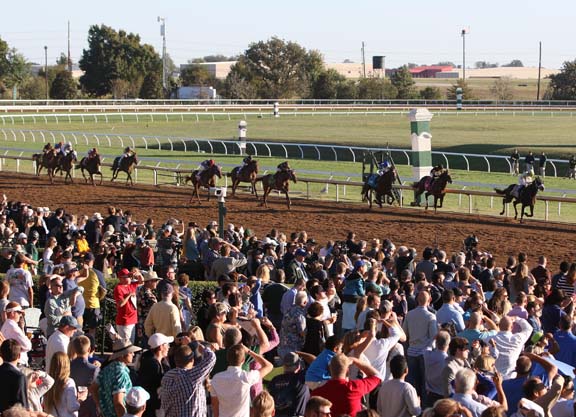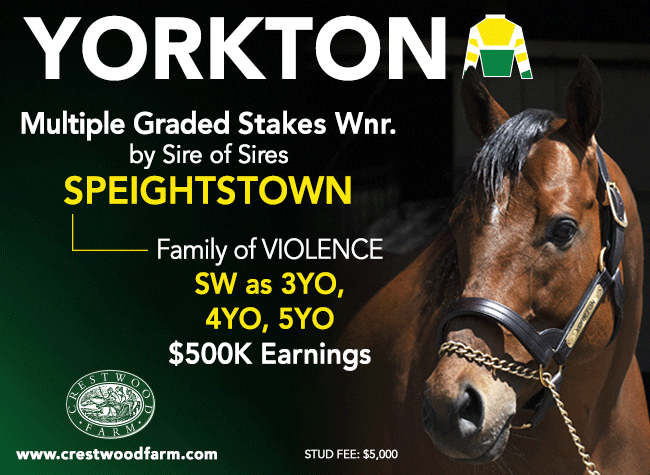By T. D. Thornton
The news that Keeneland Association, Inc., will be raising takeout rates starting with the upcoming autumn meeting sparked a backlash of horseplayer protest on social media Tuesday, including the possibility of a formal betting boycott of the track's races organized by the Horseplayers Association of North America (HANA).
Bob Elliston, Keeneland's vice president of racing and sales, confirmed in a Tuesday phone interview with TDN that the track intends to hike the take on straight wagers from 16 to 17.5%. The take on most exotic wagers will go up from 19 to 22%, with the lone exception being the Pick Five, which will drop from 19 to 15%. Daily Racing Form first broke the story.
Elliston explained that the purpose of the raised rates is to fund purses, and that those new rates represent the maximum amounts allowed by state law in Kentucky, which has a two-tiered system that allows tracks to implement the higher takeouts if average daily on-track handle is below $1.2 million. He added that Keeneland's on-track betting has been below that threshold for several years, but that the association has held off on raising rates.
“We don't like to impose additional expenses on our handicappers and the folks who support our races unless there is a competitive reason for doing so,” Elliston said. “And that's where we find ourselves. Historically, Keeneland has been significantly lower than other major racing jurisdictions–on a blended takeout basis, 2% lower than other major racing jurisdictions. At the same time, we're competing to have the very highest quality racing, which means fueling purses.
“We have risen purses at our most recent spring meet, as well as last fall's, to record levels, and we do that because our competitors at that time, primarily NYRA and California…and Oaklawn…have very high competitive purses as well,” Elliston continued. “Keeneland has historically paid more than we are contractually obligated to with our horsemen, because that's the Keeneland mission…. We're still among the very lowest rates in the country, and pretty close, within half a point, of other major racing jurisdictions.”
But Jeff Platt, the president of the HANA, doesn't buy Keeneland's reasoning for the rate increase. He said the move could backfire on Keeneland, which has historically attained a high marks on HANA's annual Track Rating System, a methodology that uses quantitative factors such as takeout, field size, handle, and signal distribution to come up with bettor-friendly rankings of all North American pari-mutuel Thoroughbred venues (view the list here).
“I guess my first reaction is that I am extremely disappointed that Keeneland would do this to horseplayers,” Platt said in a phone interview. “My second reaction and prediction is that this is actually going to cause purse money to go down, that they're actually going to have purse cuts as a result of this, not purse increases.”
Platt said that HANA members are “tossing around the possibility” of organizing a betting boycott similar to the one HANA backed in 2014 when Churchill Downs used the same state law to increase its takeout rates.
“HANA is a corporation. We have a board. We're going to talk about it. We'll vote on [organizing a boycott],” Platt said. “But whether we do it, or whether some other horseplayers take the ball and run with it, there's going to be a boycott, and there is going to be significant players' pushback.”
But will a boycott truly have any long-term impact on Keeneland's betting business? While HANA took credit for its boycott leading to a $48 million decrease in total handle at Churchill's 2014 spring meet, Daily Racing Form noted that Churchill's all-sources wagering subsequently rose in 2015 and 2016.
“Players are going to bet less as a result of this. There's no question in my mind,” Platt said. “If Keeneland is truly going to have the same rates as Churchill, there are going to be other tracks that offer more value on the wagering menu. There is no question about it. Players will gravitate to where they get the most bang for their buck. Even if we don't boycott, I have just a gut feeling that the market is going to speak and will do something similar [in terms of eroding handle].”
Elliston was firm in his belief that no such thing would happen.
“I would hope that handicappers view [takeout increases] across that prism of what it is that Keeneland expects to do with these resources, and that this pricing continues to be competitive with other places that they could possibly be wagering,” Elliston said. “So again, I think at the end of the day when the handicappers see the quality of racing we put on, [and] have a great experience when they come to the track, and know how we're spending those monies back to promote the sport at the very highest level, I believe that they're going to continue to support our racing.”
When asked if he could pinpoint a ballpark figure for how much purses would go up as a result of the takeout hike, Elliston declined to venture a guess.
“I don't have the actual figure, because it's a speculative number based on how much handle we have,” Elliston said. “But suffice it to say, I think it will allow us to continue to grow and to put monies back in the pockets of horsemen who are choosing to race here.”
Elliston pointed out that over the past five years, Keeneland has overpaid purses beyond contractually stipulated levels by about $30 million, or $6 million annually.
“We had record purses in the spring and fall without the benefit of this comparative price difference,” Elliston said. “We were actually at a disadvantage because we were pricing our premium product at significantly lower terms.”
Platt offered a counter-argument to Elliston's reasoning: “They also put in Instant Racing machines, did they not? Kentucky Downs put in Instant Racing machines and lowered their exacta takeout, and it paid huge dividends for them.” (The Instant Racing machines in Lexington are operational about six miles away at The Red Mile, Keeneland's partner harness track.)
In fact, Platt noted, Kentucky Downs was the track that unseated Keeneland's six-year reign as the No. 1-rated track in the continent on the HANA list, in part because of that decision to cut exacta takeouts to 18.25%.
Keeneland currently ranks No. 3 on the HANA track list, but Platt said the takeout increase has rankled him to the point where he might consider a mid-season reshuffling of the rankings, which are traditionally released annually.
“My gut is that yeah, we'll probably readjust the rankings, and they'll fall down significantly in the rankings as a result of this,” Platt said.
For perspective, sorting the HANA track list by exacta takeout rates reveals that there are currently only five other race meets in North America with exacta takeouts lower than 19%. But the boost to 22% would put 41 other tracks ahead of Keeneland in terms of lower exacta takeouts.
Elliston said he was well aware of where Keeneland stood in the HANA rankings, but didn't think the readjusted takeouts would affect the track's standing all that much.
“We rank high in that [rankings] list of HANA,” Elliston said. “Our pricing will remain comparatively similar to those tracks, and so I would expect that we would continue to see that objective viewpoint.”
Platt, on a personal level, said that upon learning the news of Keeneland's takeout increase, he immediately rethought a planned trip to Lexington this autumn to attend the Keeneland races.
“I'm going to cancel my trip. I can't see going,” Platt said. “I'll go somewhere else–don't know where yet. I'll bet somewhere else, and I'll make sure that every horseplayer in North America knows that Keeneland has raised their takeout. It's hard to keep that secret.”
Not a subscriber? Click here to sign up for the daily PDF or alerts.






